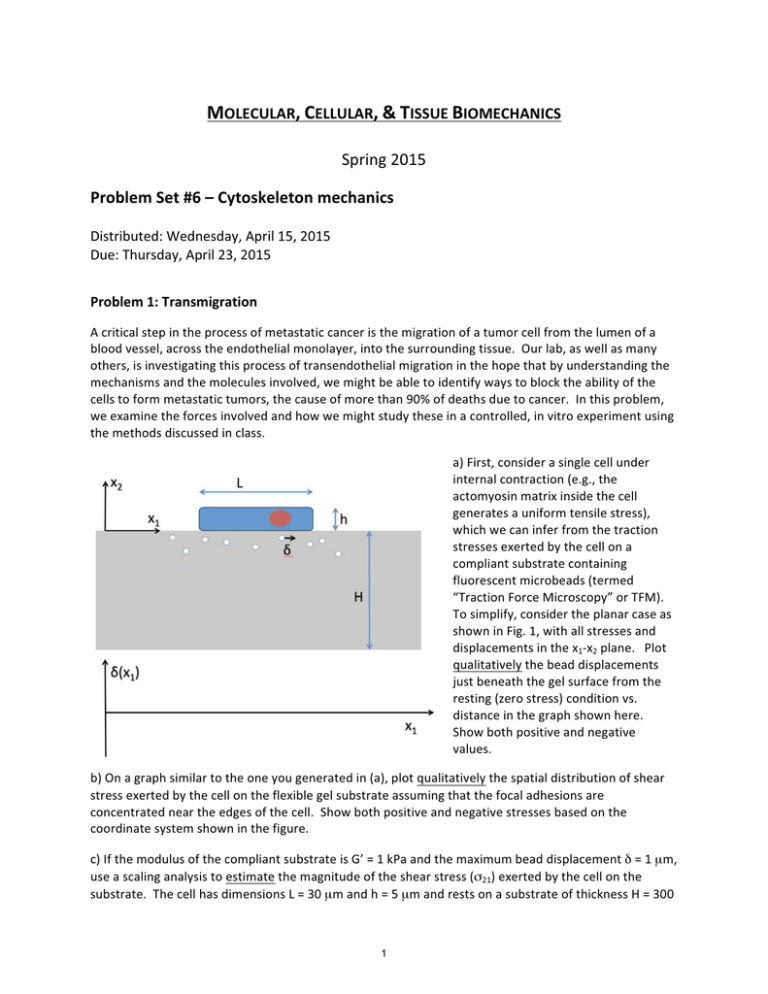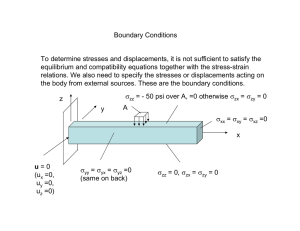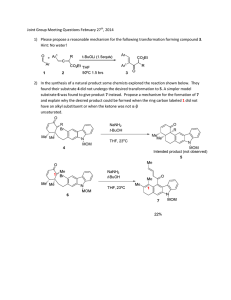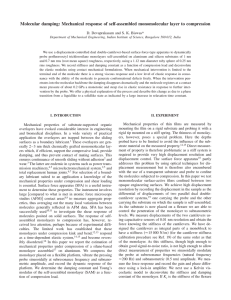M , C &
advertisement

MOLECULAR, CELLULAR, & TISSUE BIOMECHANICS Spring 2015 Problem Set #6 - Cytoskeleton mechanics Distributed: Wednesday, April 15, 2015 Due: Thursday, April 23, 2015 Problem 1: Transmigration A critical step in the process of metastatic cancer is the migration of a tumor cell from the lumen of a blood vessel, across the endothelial monolayer, into the surrounding tissue. Our lab, as well as many others, is investigating this process of transendothelial migration in the hope that by understanding the mechanisms and the molecules involved, we might be able to identify ways to block the ability of the cells to form metastatic tumors, the cause of more than 90% of deaths due to cancer. In this problem, we examine the forces involved and how we might study these in a controlled, in vitro experiment using the methods discussed in class. a) First, consider a single cell under internal contraction (e.g., the actomyosin matrix inside the cell generates a uniform tensile stress), which we can infer from the traction stresses exerted by the cell on a compliant substrate containing fluorescent microbeads (termed "Traction Force Microscopy" or TFM). To simplify, consider the planar case as shown in Fig. 1, with all stresses and displacements in the x1 x2 plane. Plot qualitatively the bead displacements just beneath the gel surface from the resting (zero stress) condition vs. distance in the graph shown here. Show both positive and negative values. b) On a graph similar to the one you generated in (a), plot qualitatively the spatial distribution of shear stress exerted by the cell on the flexible gel substrate assuming that the focal adhesions are concentrated near the edges of the cell. Show both positive and negative stresses based on the coordinate system shown in the figure. c) If the modulus of the compliant substrate is G' = 1 kPa and the maximum bead displacement δ = 1 μm, use a scaling analysis to estimate the magnitude of the shear stress (σ21) exerted by the cell on the substrate. The cell has dimensions L = 30 μm and h = 5 μm and rests on a substrate of thickness H = 300 1 μm (not drawn to scale in the figure). The focal adhesions can be assumed to extend a length L/5 at both ends of the cell. d) Stresses acting at the cell substrate interface are due to motor activity inside the cell, giving rise to a roughly uniform internal prestress in the cytoskeleton. Using your calculations above, draw an appropriate control volume and use it to estimate the normal stress (prestress) acting on the mid plane of the cell. (If you couldn't answer (c), then express your answer in terms of an unknown maximum shear stress σmax.) e) Now consider a cell monolayer consisting of many cells extending in the positive and negative x1 directions (see below). Again, plot the displacements of beads within the gel substrate as a function of position, assuming for this part that there is no stress transmitted between cells through the cell cell junctions. f) Now consider a situation where the amount of (tensile) stress transmitted through the cell cell junction is non zero, while assuming that the stress internal to the cell remains constant. What is the effect on your plot in (e)? g) One of the fundamental questions that arises in the context of tumor cell transmigration, is whether the tumor cell forces its way through the endothelial monolayer or induces the endothelium to release the cell cell junctions allowing the tumor cell to pass through easily. How might you use traction force microscopy to address this question? A one paragraph answer should be sufficient. (Note that there is likely to be more than one correct answer to this. We are looking more for a logical thought process rather than THE one correct answer.) h) By using fluorescent probes, it is observed that the F actin concentration, at the point where the tumor cell is entering, appears to be higher by approximately a factor of two compared to the rest of the cell. Based on the tensegrity microstructural model for the cytoskeleton, by how much would you expect the modulus of the cell to increase? (You may need to make some assumptions to answer this problem. If so, state them clearly.) 2 Problem 2 - Microstructural model Consider a very simplified model for a random network of macromolecules, in which we represent the network as an array of molecules arranged in a cubic lattice, as schematically shown in the figure. The molecules are crosslinked at the junction points (the small circles at the corner) and this single unit cube of molecules is repeated in space to make up the molecular network. Assume that all the molecules have the same properties: N links of Kuhn length h, and can be modeled as Gaussian chains at temperature T. The equilibrium length, ro, of each molecule is r0 = b 2N / 3 . a) If we load this molecular network along the vertical direction indicated in the figure, what will be the measured macroscopic Young's modulus, E? What will be the Poisson ratio, ν? b) What happens to the Young’s modulus if we increase the temperature? Why? 3 Problem 3: Paper abstract The third part of this assignment is to write an abstract for your term paper, following the guidelines in the course materials handed out earlier (see below and also posted on Stellar). Your abstract to be handed in with this assignment should be approximately 250 words, providing a description of the topic, how it fits with the course material, and the names of others in your group. Everyone should hand in their own abstract, however, it can be the same for all members of your group. Course Project and Term Paper guidelines The Course Project is designed as a team effort for groups of approximately 3 students. Teams are expected to hand in a written report and present their work in a brief presentation to the class at the end of the term. The report is to be written entirely by the team. You should acknowledge other sources with proper citations. The project will entail a detailed spec sheet summarizing various aspect of your chosen biological component. We have posted a sample spec sheet on the Stellar site. We encourage you to expand on the sample spec sheet and contribute your own creativity. Overall, we expect the following: The spec sheet should be between 5 - 10 pages in length. You can use the sample/template spec sheets posted on the Stellar site as guide. Feel free to come up with your own spec sheet organization scheme as well. Extra points for creativity. We are looking not only for breath but also depth in your spec sheets. Some topics (not limited) to consider are: o Background / components / subcomponents o Structure and function/role relevant to biology and biomechanics o Tools used to study the biological component o Role in disease o Models used to study the biological components o Future Research / Applications o Interesting unanswered questions o Research groups and their web address working on this system For each topic you consider, make sure to include figures and captions detailing important findings. We expect you to critically discuss the relevance (What does this figure show and why is it important?) of such figure and not simply copy a caption straight from the literature reference. Be sure to cite your references. Feel free to use PubMed and Web of Science when doing your research. No Wikipedia references and use original sources (manuscripts and books, rather than websites or databases) wherever possible. 4 MIT OpenCourseWare http://ocw.mit.edu 20.310J / 3.053J / 6.024J / 2.797J Molecular, Cellular, and Tissue Biomechanics Spring 2015 For information about citing these materials or our Terms of Use, visit: http://ocw.mit.edu/terms.






